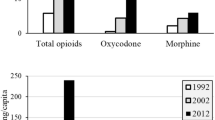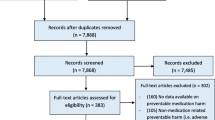Abstract
The aim was to describe the exposure to excipients among neonates hospitalised in the neonatal intensive care unit (NICU) of a public hospital in Brasilia, Brazil. This was a retrospective study based on medicines that were prescribed electronically to neonates (≤28 days) who were admitted to the NICU of a hospital in Brasilia between January 1 and March 31, 2012. Excipients were identified from the medicine package leaflets and were classified according to toxicity. Seventy-nine infants received a total of 1,303 prescriptions comprising 77 formulations and 70 active drugs. Eighty-six excipients were identified, of which, 9 were harmful excipients (HE) and 48 were potentially harmful excipients (PHE). Almost all the neonates (98.7 %) were exposed to at least one HE and PHE. Preterm neonates (n = 64; 1,502 neonate days) presented high risk of exposure to polysorbate 80 (3.26/100 neonate days), sodium hydroxide (3.39), PG (3.19) and propylparaben (3.06). Full-term neonates (n = 15; 289 neonate days) presented risks in relation to phenol (4.84), ethanol (3.8) and sodium citrate (3.46). Conclusion: Neonates in NICUs in Brazil are exposed to a wide variety of HE and PHE with unpredictable results. Safer alternatives are needed, as well as further studies on the subject.

Similar content being viewed by others
References
Allegaert K, Langhendries JP, van den Anker J (2013) Do we need neonatal clinical pharmacologists? Eur J Pediatr 172(4):429–435. doi:10.1007/s00431-012-1734-4
Allegaert K, Vanhaesebrouck S, Kulo A, Cosaert K, Verbesselt R, Debeer A, de Hoon J (2010) Prospective assessment of short-term propylene glycol tolerance in neonates. Arch Dis Child 95(12):1054–1058. doi:10.1136/adc.2010.190330
ANVISA (2013) Bulário Eletrônico. http://www4.anvisa.gov.br/BularioEletronico. Accessed 01 June 2013
Calafat AM, Weuve J, Ye X, Jia LT, Hu H, Ringer S, Huttner K, Hauser R (2009) Exposure to bisphenol A and other phenols in neonatal intensive care unit premature infants. Environ Heal Perspect 117(4):639–644. doi:10.1289/ehp.0800265
Carvalho CG, Ribeiro MR, Bonilha MM, Fernandes M Jr, Procianoy RS, Silveira RC (2012) Use of off-label and unlicensed drugs in the neonatal intensive care unit and its association with severity scores. J Pediatr (Rio J) 88(6):465–470. doi:10.2223/JPED.2231
Centralx (2013) Sistemas Inteligentes em Saúde. http://www.bulas.med.br. Accessed 01 June 2013
Coelho HL, Rey LC, Medeiros MS, Barbosa RA, Cruz Fonseca SG, Costa PQ (2013) A critical comparison between the World Health Organization list of essential medicines for children and the Brazilian list of essential medicines (Rename). J Pediatr (Rio J) 89(2):171–178. doi:10.1016/j.jped.2013.03.004
De Cock RF, Knibbe CA, Kulo A, de Hoon J, Verbesselt R, Danhof M, Allegaert K (2013) Developmental pharmacokinetics of propylene glycol in preterm and term neonates. Br J Clin Pharmacol 75(1):162–171. doi:10.1111/j.1365-2125.2012.04312.x
Dell’Aera M, Gasbarro AR, Padovano M, Laforgia N, Capodiferro D, Solarino B, Quaranta R, Dell’Erba AS (2007) Unlicensed and off-label use of medicines at a neonatology clinic in Italy. Pharm World Sci: PWS 29(4):361–367. doi:10.1007/s11096-006-9081-z
EMEA/536810/2008 (2010) Guideline on the investigation of medicinal products in the term and preterm neonate. EMEA. http://www.ema.europa.eu/docs/en_GB/document_library/Scientific_guideline/2009/09/WC500003750.pdf. Accessed 01 February 2013
EMEA/CHMP/PEG/194810/2005 (2006) Reflection paper: formulations of choice for the paediatric population. EMEA. http://www.ema.europa.eu/docs/en_GB/document_library/Scientific_guideline/2009/09/WC500003782.pdf. Accessed 01 February 2013
Fabiano V, Mameli C, Zuccotti GV (2011) Paediatric pharmacology: remember the excipients. Pharmacol Res: Off J Ital Pharmacol Soc 63(5):362–365. doi:10.1016/j.phrs.2011.01.006
Giacoia GP, Taylor-Zapata P, Zajicek A (2012) Drug studies in newborns: a therapeutic imperative. Clin Perinatol 39(1):11–23. doi:10.1016/j.clp.2011.12.016
Jacqz-Aigrain E (2011) Drug policy in Europe research and funding in neonates: current challenges, future perspectives, new opportunities. Early Hum Dev 87(Suppl 1):S27–S30. doi:10.1016/j.earlhumdev.2011.01.007
Kalikstad B, Skjerdal A, Hansen TW (2010) Compatibility of drug infusions in the NICU. Arch Dis Child 95(9):745–748. doi:10.1136/adc.2009.174268
Kulo A, de Hoon JN, Allegaert K (2012) The propylene glycol research project to illustrate the feasibility and difficulties to study toxicokinetics in neonates. Int J Pharm 435(2):112–114. doi:10.1016/j.ijpharm.2012.05.014
Lass J, Naelapaa K, Shah U, Kaar R, Varendi H, Turner MA, Lutsar I (2012) Hospitalised neonates in Estonia commonly receive potentially harmful excipients. BMC Pediatr 12:136. doi:10.1186/1471-2431-12-136
Malcolm WF, Cotten CM (2012) Metoclopramide, H2 blockers, and proton pump inhibitors: pharmacotherapy for gastroesophageal reflux in neonates. Clin Perinatol 39(1):99–109. doi:10.1016/j.clp.2011.12.015
Nahata MC (2009) Safety of "inert" additives or excipients in paediatric medicines. Arch Dis Child Fetal Neonatal Ed 94(6):F392–F393. doi:10.1136/adc.2009.160192
Nair B (2001) Final report on the safety assessment of benzyl alcohol, benzoic acid, and sodium benzoate. Int J Toxicol 20(Suppl 3):23–50
Nellis G, Metsvaht T, Lass J, Varendi H, Turner MA, Lutsar I (2013) European Study of Neonatal Excipient Exposure (ESNEE): preliminary results of the point prevalence survey. In: 14th Biannual Congress of the European Society for Developmental Perinatal and Pediatric Pharmacology (EDPPP), Salzburg, Austria, German Medicam Science GMS Publishing House, Düsseldorf. http://www.esdppp.org/site/wp-content/uploads/2013/06/ESDP%20ibook%20final%201.1%20light.pdf. Accessed 04 December 2013
Neubert A, Lukas K, Leis T, Dormann H, Brune K, Rascher W (2010) Drug utilisation on a preterm and neonatal intensive care unit in Germany: a prospective, cohort-based analysis. Eur J Clin Pharmacol 66(1):87–95. doi:10.1007/s00228-009-0722-8
Pifferi G, Restani P (2003) The safety of pharmaceutical excipients. Farmaco 58(8):541–550
Rowe RC, Sheskey PJ, Quinn ME (2009) Handbook of pharmaceutical excipients, 6th edn. Pharmaceutical Press, London
Salunke S, Brandys B, Giacoia G, Tuleu C (2013) The STEP (Safety and Toxicity of Excipients for Paediatrics) database: part 2—the pilot version. Int J Pharm 457(1):310–322. doi:10.1016/j.ijpharm.2013.09.013
Shehab N, Lewis CL, Streetman DD, Donn SM (2009) Exposure to the pharmaceutical excipients benzyl alcohol and propylene glycol among critically ill neonates. Pediatr Crit Care Med: J Soc Crit Care Med World Fed Pediatr Intensive Crit Care Soc 10(2):256–259. doi:10.1097/PCC.0b013e31819a383c
Tuleu C, Breitkreutz J (2013) Educational paper: formulation-related issues in pediatric clinical pharmacology. Eur J Pediatr 172(6):717–720. doi:10.1007/s00431-012-1872-8
Turner MA, Duncan J, Shah U, Metsvaht T, Varendi H, Nellis G, Lutsar I, Vaconsin P, Storme T, Rieutord A, Nunn AJ (2013) European study of neonatal exposure to excipients: an update. Int J Pharm 457(1):357–358. doi:10.1016/j.ijpharm.2013.08.078
Turner MA, Duncan JC, Shah U, Metsvaht T, Varendi H, Nellis G, Lutsar I, Yakkundi S, McElnay JC, Pandya H, Mulla H, Vaconsin P, Storme T, Rieutord A, Nunn AJ (2013) Risk assessment of neonatal excipient exposure: lessons from food safety and other areas. Adv Drug Deliv Rev. doi:10.1016/j.addr.2013.11.003
US/FDA (2011) FDA drug safety communication: serious health problems seen in premature babies given Kaletra (lopinavir/ritonavir) oral solution. http://www.fda.gov/Drugs/DrugSafety/ucm246002.htm. Accessed 05/12/2013
US/NLM (2013) Haz-Map®. U.S. National Library of Medicine. http://hazmap.nlm.nih.gov. Accessed 10 July 2013
US/NLM/SIS (2013) TOXNET. U.S. National Institutes of Health. http://toxnet.nlm.nih.gov/. 10 July 2013
van Riet-Nales DA, de Jager KE, Schobben AF, Egberts TC, Rademaker CM (2011) The availability and age-appropriateness of medicines authorized for children in the Netherlands. Br J Clin Pharmacol 72(3):465–473. doi:10.1111/j.1365-2125.2011.03982.x
Whittaker A, Currie AE, Turner MA, Field DJ, Mulla H, Pandya HC (2009) Toxic additives in medication for preterm infants. Arch Dis Child Fetal Neonatal Ed 94(4):F236–F240. doi:10.1136/adc.2008.146035
WHO (2010) Anatomical-therapeutical-chemical (atc) classification—index and guidelines. http://www.who.int/classifications/atcddd/en. Accessed 10 July 2013
Acknowledgement
This study was supported by grants from the Institute of Health Science—Research and Teaching Foundation—FEPECS.
Conflict of interest
The authors declare that they have no personal financial relationship with the sponsoring organisations or any other potential conflicts of interest.
Author information
Authors and Affiliations
Corresponding author
Additional information
Communicated by Patrick Van Reempts
Rights and permissions
About this article
Cite this article
Souza, A., Santos, D., Fonseca, S. et al. Toxic excipients in medications for neonates in Brazil. Eur J Pediatr 173, 935–945 (2014). https://doi.org/10.1007/s00431-014-2272-z
Received:
Revised:
Accepted:
Published:
Issue Date:
DOI: https://doi.org/10.1007/s00431-014-2272-z




